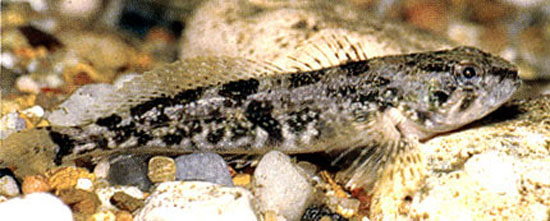| Cottidae (Sculpins) |
| 30 cm TL (male/unsexed); max. reported age: 7 years |
|
demersal; freshwater; brackish; marine, catadromous |
| North America: Pacific slope drainages from Seward, Alaska to Ventura River, California, USA; also east of Continental Divide in upper Peace River in British Columbia, Canada. Exhibits coastal and inland forms that are genetically distinct (Ref. 27547). |
|
Dorsal spines (total): 7-10; Dorsal soft rays (total): 18-23; Anal spines: 0-0; Anal soft rays: 15-19; Vertebrae: 34-39. Distinguished by a complete lateral line, a single pore at the tip of the chin, the presence of 15 to 19 anal rays, and well developed palatine teeth (Ref. 27547). Pectorals large and fan-shaped; caudal truncate or slightly rounded (Ref. 27547). Dark brown, olive or gray above and on sides, whitish yellow to white below; usually three dark irregular blotches or bars below soft dorsal; vague irregular dark mark on sides; fins (except anal) have dark bars, the first dorsal with a dark spot towards the rear (Ref. 27547). Both sexes show an orange band on the edge of the first dorsal fin at spawning time (Ref. 27547). The inland form is generally more densely prickled over a larger portion of the body while the coastal form shows a reduced number of prickles (Ref. 28211). |
| There appears to be two genetically distinct forms (Ref. 27547), an inland form found in sandy and rocky shores of lakes, and a coastal form usually found over sand in quiet runs of small to medium rivers; sometimes in salt water near river mouths (Ref. 2850). The coastal form moves into brackish estuaries to spawn (Ref. 27547). Oviparous with demersal, adhesive eggs and pelagic larvae (Ref. 265). Feed mainly on aquatic insect larvae and bottom invertebrates (Ref. 1998). Too small to be used as food and too difficult to capture in large numbers to be used for anything else (Ref. 27547) but large individuals are reported to be excellent eating as well as good bait fishes (Ref. 2850). |
|
Least Concern (LC); Date assessed: 08 November 2011 Ref. (130435)
|
| harmless |
Source and more info: www.fishbase.org. For personal, classroom, and other internal use only. Not for publication.

